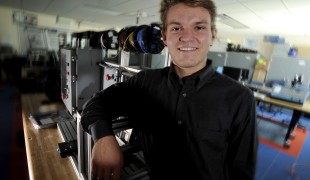- 8340
- 621
- 6
- 7
- 0
- Help Ukraine
About the solution
Tom felt the need to create different splints because the traditional ones were difficult to put on, because of the Velcro, and were cumbersome and not very nice to look at.
“After the accident it soon became quite obvious there was a lack of wrist supports to help with brachial plexus injuries. I was looking for something minimal. All the wrist supports I’ve had were very medical and stood out, and the more I was recovering, the less I wanted it to look like I had an injury”, the patient explained.
These splints are being tested at Hospital Morriston, Wales, and are custom-made to fit the patient, having flexible casts which also be made in a range of designs and colors, also being made of a more solid and durable material.
The splints are printed from a 3D scan of the patient’s arm, which is 3D printed so the 3D printed splint can be fit to it perfectly, and then they are tested by the patient.
"The prototype casts are tied with bungee cords, which make them easier to get on and off. It also has a little face for a watch and can be printed in any color or pattern. You can even have your name on it, so you can really personalize it in any way you want. There’s nobody else in the world that has actually produced anything like this. Once we’re happy with the prototype and satisfied with the fit and function of the design, it could be used for numerous other conditions such as fractures and stroke patients”, Marc Lloyd expressed.
Adapted from: http://bit.ly/1YhnlcN
This solution shall not include mention to the use of drugs, chemicals or biologicals (including food); invasive devices; offensive, commercial or inherently dangerous content. This solution was not medically validated. Proceed with caution! If you have any doubts, please consult with a health professional.
DISCLAIMER: This story was written by someone who is not the author of the solution, therefore please be advised that, although it was written with the utmost respect for the innovation and the innovator, there can be some incorrect statements. If you find any errors please contact the patient Innovation team via info@patient-innovation.com
-
-
1250
-
43
-
53218

Robohand - A 3D-printed thermoplastic mechanical hand
Grip
Studying
Limb Amputation
3d Printed
Body-Worn solutions (Clothing, accessories, shoes, sensors...)
Difficulty walking or moving
Limited range of motion
Reduced grip force (grip)
Joint deformity
Joint redness or warmth
Joint pain or swelling
Restoring mobility
Replacing lost limbs
Promoting self-management
Managing Neurological Disorders
Promoting inclusivity and social integration
Recovering from Traumatic Injuries
To improve Treatment/Therapy
Neurology
Orthopedics
Pediatrics
Vascular Surgery
United States
-
-
-
582
-
10
-
10782

Teen develops workout gear for his mother
Grip
CAREGIVING
Carpal Tunnel Syndrome
Arthritis
obesity
Chronic Back Pain
3d Printed
Assistive Daily Life Device (to help ADL)
Muscle weakness
Muscle cramps or spasms
Stiffness or rigidity (difficulty moving)
Limited range of motion
Muscle pain or stiffness
Joint redness or warmth
Numbness or tingling in the extremities
Difficulty bearing weight
Muscle twitching
Joint pain or swelling
Weight gain
Restoring mobility
Managing pain
Managing Neurological Disorders
Endocrinology
General and Family Medicine
Neurology
Orthopedics
Public Health
Rheumatology
United States
-
-
-
488
-
0
-
6324

Woman invents 3D printed aid for paraplympic friend
BODY BALANCE: Maintaining body balance
Cycling
MOVING IN A WHEELCHAIR: Moving using a wheelchair.
Brain Stroke
Stroke
Spinal Cord and Nerve Root Disorders
Cervical spinal cord injury/Tetraplegia
3d Printed
Walking Aid (wheelchair/walker/crutches)
Body-Worn solutions (Clothing, accessories, shoes, sensors...)
Muscle cramps or spasms
Difficulty coordinating movements
Stiffness or rigidity (difficulty moving)
Paralysis of the legs and lower body
Muscle weakness
Loss of balance
Numbness or weakness in the legs
Unilateral leg swelling.
Restoring mobility
Replacing lost limbs
Managing Neurological Disorders
Maintaining Balance and Mobility
Cardiology
General and Family Medicine
Neurology
Sports Medicine
United States
-
 en
en